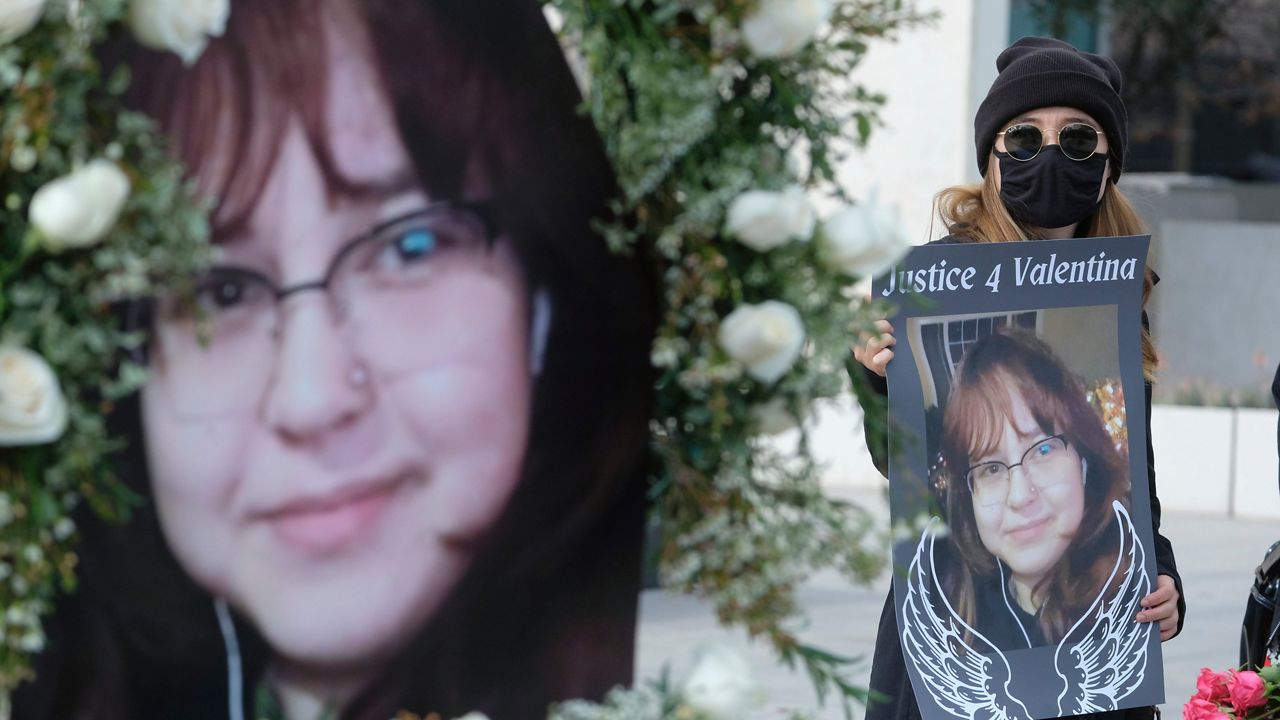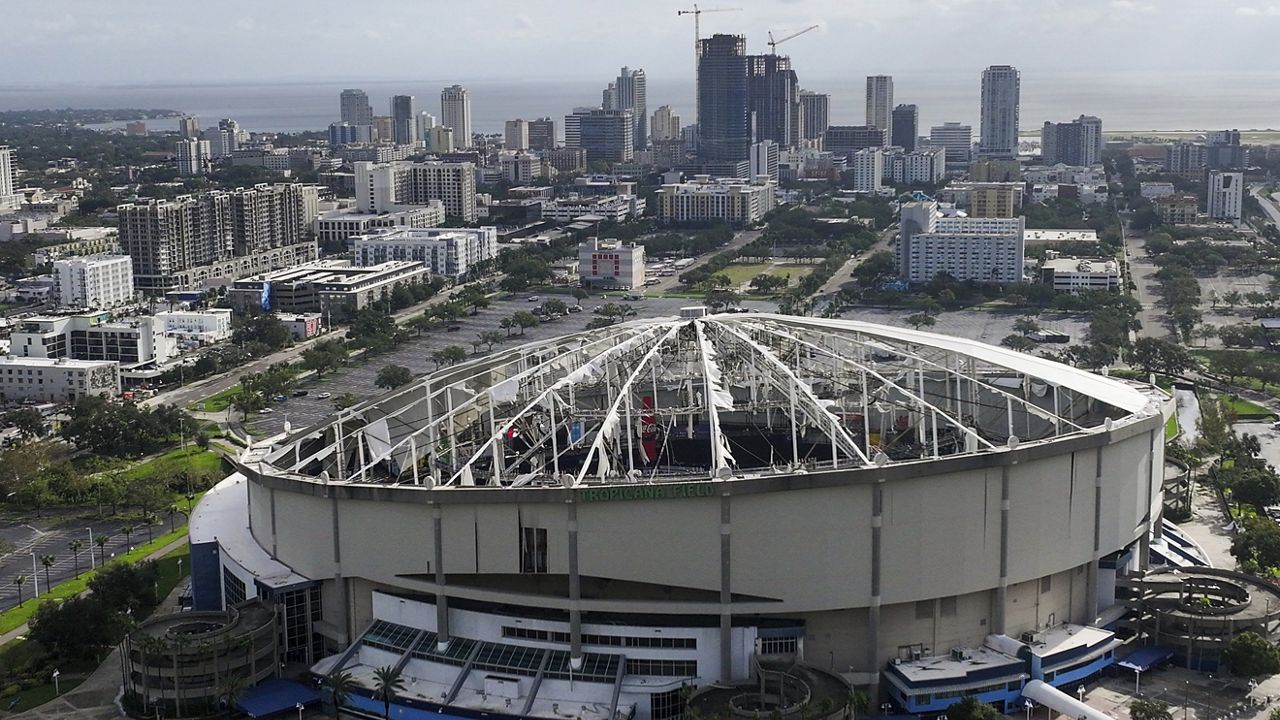On Dec. 23, Los Angeles police shot and killed a man who allegedly assaulted customers inside a clothing store — and, in the process, killed Valentina Orellana-Peralta, a 14-year-old bystander who was hiding in a dressing room with her mother.
She died in her mother's arms.
“We sat down on a seat, holding each other, praying, when something hit my daughter, Valentina, and threw us to the floor,” Soledad Peralta said Tuesday, as her family stood outside of Los Angeles Police Department headquarters, calling for justice and transparency. “And my daughter died in my arms. I couldn’t do anything.”
As of Dec. 23, 2021, at least 1,051 people were killed by police across the United States, according to Mapping Police Violence, a citizen data collection project that tabulates reports of homicides by police found in the media — 6.7% decrease from 2020, when at least 1,126 were killed.
And despite the racial justice movement that dominated much of 2020 after the murder of George Floyd sparked global uproar – very little has changed.
Nearly three people were killed each day by police across the United States in 2021 according to a citizen database recording every report of a fatal police shooting across the country. That’s in keeping with recent annual trends, hovering around 1,100 deaths per year.
“It’s a similar number of people who have been killed by police this year as in previous years … 1,051 so far, to date, but will probably be revised as we find more cases in the coming weeks,” said Samuel Sinyagwe, a policy analyst, data scientist and racial justice activist.
Sinyagwe built the Mapping Police Violence database and co-founded Campaign Zero, which seeks data-driven solutions to curb police violence. His project came out of necessity: National police use-of-force data has been hard to come by.
Despite a 2014 federal law that requires data collection from local law enforcement agencies regarding deaths during arrests, as well as deaths in prisons, jails and detention centers, little data exists. In fact, the federal Bureau of Justice Statistics notes that the Mortality in Correctional Institutions project (formerly the Deaths in Custody Reporting Program) is inactive; its latest data available is from 2017, and the project stopped collecting new information in 2019.
Sinyagwe was inspired to track data following the Ferguson uprisings in 2014, when 18 year old Michael Brown was shot and killed by a police officer. Brown’s death, and the controversy surrounding Ferguson, Missouri, police officer Darren Wilson, ignited a new wave of political and social discussions regarding use of force and police brutality. That conversation came to a head in 2020, following the murder of Floyd by a Minneapolis police officer.
In October, the Los Angeles City Council approved a plan to create unarmed crisis response teams that would respond to non-violent emergency calls, such as mental health crises. For nearly two decades, LAPD has deployed paired teams of armed officers and mental health clinicians to crisis situations.
CAHOOTS, a similar unarmed crisis program out of Eugene, Oregon, has become a model for crisis services across the country, and was frequently mentioned as Los Angeles city staffers built its own program. The CAHOOTS model deploys a two-person team of a medic and a crisis worker to non-violent crisis and non-emergency medical calls. According to a Eugene Police Department report, CAHOOTS teams called for police backup in only 2% of its calls.
What Sinyagwe has found in 2021 is that police-related homicides have increased in rural areas, but fallen in large metropolitan areas.
“That being said, Los Angeles is an aberration in that trend,” Sinyagwe said, noting that homicides by LAPD officers have more than doubled in 2021 compared to the year prior — from 7 in 2020 to 18 to date in 2021. That comes despite a decrease in serious crime in 2021 compared to 2019, even with an increase in violent crime.
The year 2021 saw former Minneapolis police officer Derek Chauvin convicted of the murder of George Floyd and sentenced to 22 1/2 years in prison. In December, Chauvin also pleaded guilty to federal civil rights charges in Floyd's murder, as well as to violating the rights of a 14-year-old boy during a 2017 arrest in which he held the boy by the throat, hit him in the head with a flashlight and held his knee on the boy’s neck and upper back while he was prone, handcuffed and not resisting.
December of 2021 also saw former suburban Minneapolis police officer Kim Potter guilty of first- and second-degree manslaughter in the shooting of Black motorist Daunte Wright during a traffic stop in April of this year. Potter said she meant to use her taser on Wright instead of her gun.
While a number of states have enacted police reforms in the wake of last summer's racial justice protests, far-reaching nationwide change is still up in the air.
In Maryland, the state's Democratic-controlled legislature repealed their powerful Law Enforcement Officers Bill of Rights, overriding the veto of Republican Gov. Larry Hogan and passing a number of other reforms, including expanding public access to police disciplinary records and creating a unit in the state attorney general’s office to investigate police-involved deaths.
Washington state banned police from using chokeholds and no-knock warrants, create a new state agency to investigate police use of deadly force and change the threshold for when officers can use force.
Kentucky, which boasts a Republican supermajority in their legislature, despite having a Democrat in the Governor's mansion, passed a partial ban on no-knock warrants after months and months of demonstrations in the aftermath of the fatal shooting of Breonna Taylor in her Louisville home during a botched police raid last year.
North Carolina Gov. Roy Cooper, also a Democrat, signed a bill passed by the Republican-led legislature that creates a public database where anyone can check whether an officer’s certification has been suspended or revoked and creates a confidential database showing cases in which an officer kills or seriously injures someone that is only accessible to law enforcement agencies.
Louisiana, another similarly split state, passed new restrictions on the use of chokeholds and no-knock warrants, required detailed policies for body camera and dash camera use, boosted law enforcement agencies’ minority recruitment efforts, required anti-bias training, and mandated suspension or revocation of a police officer’s state certification if the officer committed misconduct.
And California created a statewide certification system for officers, in part to prevent police fired in one jurisdiction from getting a job somewhere else. It also required the state attorney general’s office to investigate all fatal shootings by police of unarmed civilians, specified when officers have a duty to intervene to prevent or report excessive force, and increased the minimum age to become a police officer from 18 to 21.
“This is not an anti-police bill. This is an accountability bill,” California Assemblywoman Akilah Weber, a Democrat, said. “Without any accountability, we lose the integrity of the badge, and the bond with the community is broken.”
Some states have atually moved in the opposite direction: Iowa Gov. Kim Reynolds introduced a bill that would ban racial profiling by police and establish a system to track racial data for police stops; instead, lawmakers passed a bill called the Back the Blue Act, which dropped those provisions and made rioting a felony, provides legal protections for drivers of vehicles who might strike a protester and made it harder to sue and win monetary damages against police officers accused of misconduct.
Gov. Reynolds, a Republican, signed that bill into law in June.
Following an incident in Tulsa, Oklahoma, where the driver of a pickup truck plowed into a group of protesters on an interstate, the state's Republican Gov. Kevin Stitt signed a bill that would grant immunity to drivers who unintentionally injure or kill protesters.
"We are sending a message today in Oklahoma that rioters who threaten law abiding citizens' safety will not be tolerated," Stitt said in April. "I remain unequivocally committed to protecting every Oklahoman's First Amendment right to peacefully protest as well as their right to feel safe in their community."
Ohio and Florida also passed measures attempting to crack down on protesters this year. A federal judge blocked Florida's law, calling it "vague and overbroad."
But on the federal level, the George Floyd Justice in Policing Act, which would ban chokeholds and carotid holds, ban no-knock warrants in federal drug cases, end qualified immunity, create a nationwide police misconduct registry and improve training and invest in community-based programs, has stalled.
The measure passed the House of Representatives in March, but the bill collapsed in the Senate when Republican Sen. Tim Scott of South Carolina, who led negotiations on the bill for the GOP, ended the discussions.
President Joe Biden, who staunchly supported the bill, pumped momentum into talks with a nationally televised address telling Congress to “get it done” by May 25, the anniversary of George Floyd's murder. But negotiators blew through that deadline and others set by the lawmakers until the deal fell apart.
Scott said that he was "deeply disappointed" in a statement, but blasted Democrats, claiming that they "squandered a crucial opportunity to implement meaningful reform to make our neighborhoods safer and mend the tenuous relationship between law enforcement and communities of color."
"The areas where we agreed — banning chokeholds, limiting the transfer of military equipment, increased mental health resources, and more — would have brought justice to these families," Scott said. "I’ve also heard from police and sheriffs groups who supported the work we were doing to provide more resources to implement better training, standards, and accountability for departments."
"The talks are over. We did the best we could," California Rep. Karen Bass, one of the Democrats negotiating the compromise. "It wasn't like there was a big fight. It wasn't like there was a big rupture. But at a certain point, you have to recognize that you're just spinning your wheels."
“We made tremendous progress,” New Jersey Sen. Cory Booker, the other Democratic negotiator, told Mother Jones in October. “But it turned out that my Republican negotiating partner was not willing to embrace so much of the change that we had agreed upon.”
Democrats in the majority have pledged to move forward with this legislation, but Congress has a stacked agenda in 2022, with voting rights, Biden's Build Back Better budget bill and other items on the horizon.
While the family of Valentina Orellana-Peralta mourns, Angelenos seek to better understand the circumstances around the shooting, in which an LAPD officer fired a rifle, killing assault suspect Daniel Elena-Lopez. Elena-Lopez is alleged to have attacked a woman at a Burlington store in North Hollywood.
Police released footage of the incident on Monday, including security cameras from inside the store, as well as LAPD body worn cameras. Footage showed Elena-Lopez swinging what appeared to be a bicycle lock around the store before attacking a bystander. When police arrived, a group of officers, including one with a long rifle and another with a 40 mm less-lethal foam round launcher, approached the location of Elena-Lopez and the assault victim.
The officer holding the rifle fired three rounds.
As officers called out “shots fired,” Elena-Lopez collapsed. Beyond them, a woman was heard screaming.
According to LAPD, the preliminary investigation indicates that an officer’s round skipped off of the floor and pierced the dressing room wall, hitting Valentina Orellana-Peralta. According to a coroner report, Orellana-Peralta was struck in the chest. Both Elena-Lopez and Peralta were pronounced dead at the scene.
During a press conference, Soledad Peralta described holding her daughter as she died in her arms, calling it “one of the greatest and most profound pains that any human can imagine.”
An investigation into the shooting, led by the California Attorney General’s office as per state law, is underway.
While data regarding police use of force is sparse on the federal level, states are beginning to pick up the slack with new legislation, Sinyagwe said. New York state, New Jersey and California are each collecting and providing policing data. New Jersey requires officers to report detailed use of force information to a statewide database within 24 hours of an incident.
“We’re beginning to see a lot more data now than we’ve ever had access to,” Sinyagwe said. “Over time, I think we could get closer to what actually works.”
The Associated Press contributed to this report.










